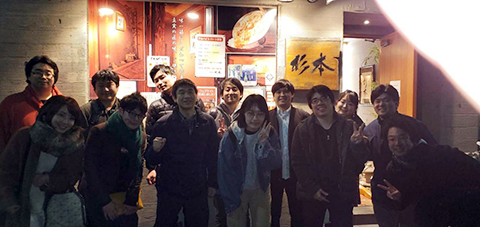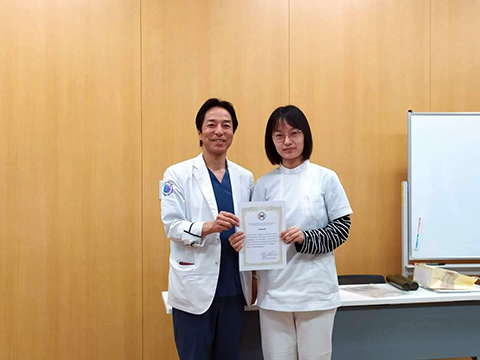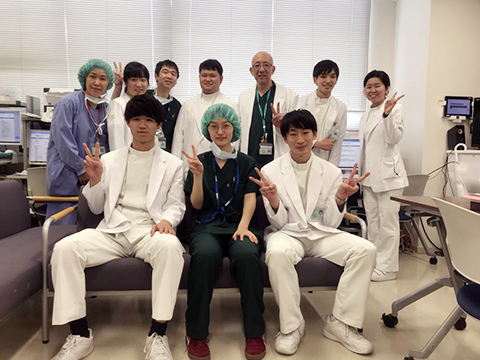国際・国内交流
劉思雅(Siya Liu)さん(中国・天津医科大学 第4学年次)
Report on clinical internship in Hyogo College of Medicine
Minutes before the plane landed, I looked out of the porthole, and the dark sea under the night was dotted with the light of a star-point fishing boat. The brightly lit Osaka in the distance was the golden necklace of the bay, and my heart beat faster- A completely new journey will begin here. As one of the two students who seized this valuable exchange opportunity, I finally chose Anesthesiology Dept. and Neurosurgery Dept. as my internship department and it turned out that this choice absolutely did not regret me. My experience in these two departments gave me a lot of warmth and indelible memories. Now I would like to share my precious memories at Hyogo College of Medicine from three aspects of life, academics and travel:
Life:
First of all, I would like to thank Hyogo College of Medicine for preparing such a comfortable and warm detached house as our guest house. This Japanese-style house and the surrounding quiet neighborhood give us the feeling the daily life. The 24-hour supermarket TRIAL next to the guest house has brought great convenience to our lives. Going to the supermarket with friend every day after internship makes us feel a bit happy in life; And of course, you can’t come to Japan without trying Japanese food: Sushi, Sashimi, Tonkatsu Rice bowls, Japanese-style yakiniku, Yakitori, Takoyaki, Ramen noodles filled with barbecued pork ... all kinds of Japanese food made me feast.
When it comes to life, communication with people is indispensable, and the Japanese people most impressed me by being polite and thoughtful. The security guard at the entrance of each building will greet you with a smile when you enter the door; the transportation coordinator at the crossroads will always smile and guide the passersby and passing vehicles; the aunt in the student cafeteria will serve you with a vigorous greet saying "Please enjoy your meal"; although the salesperson at the post office couldn’t understand English, she still tries her best to communicate with you and uses drawing to explain things; not to mention the doctors and nurses when facing patients ... They are always smiling to you and not only I see friendly in the smiles, but also confidence and dignity.
Internship: Anesthesiology Dept.
The internship in Anesthesiology Dept. is mainly composed of three parts: observation of surgical anesthesia; clerkship in Pain clinic and ICU; observation in IVR center. There is a regular conference held at 8 o’clock every morning and professors, anesthesiologists, and also some student doctors will attend. After the morning meeting, under the guidance of Dr. Nakamoto, I was able to choose the surgery I was interested in to observe, and watched as many types of surgical anesthesia as possible: brain surgery (aneurysm clipping); cardiovascular surgery (mitral valve replacement, mitral valve repair); etc. Different from the abstract concepts I have only encountered in textbooks before, during my observations, I learned more about anesthesia devices, such as arterial catheters, double-lumen endotracheal tube intubations, laryngeal masks, Swan-Ganz catheters, etc. A lot of theoretical knowledge was also able to combine with practice: What are the indications for subdural anesthesia, subarachnoid anesthesia and general anesthesia? What are the most commonly used inhaled anesthetics, intravenous anesthetics and muscle relaxants? What is the difference between fentanyl and remifentanil? ...... Many questions that were not clear in the theoretical study are more intuitively answered in actual case application. In addition, by watching the surgery, I also experienced the entire workflow of the anesthesiologist, and gained more understanding of the work content of the Anesthesia Department.
Doctors in Anesthesiology Dept. are all so kind and hospitable and I really enjoyed my stay in this warm department. Although there are some difficult medical terms that lead to communication obstacles, Dr. Nakamoto will always be patient and try to explain the terms to me as clear as possible; Dr. Ueki is very friendly and willing to share ideas with me; because outpatients complaint in Japanese, Professor Hirose would introduce the patient's general situation to me before calling the patient and after the consultation, he would explain the specific situation of the patient and the selected treatment and method; Professor Takao invited me to join their afternoon tea and dinner, and was very concerned about the epidemic condition in our country...Although that was a only short stay for 10 days, I felt like in a big warm family.
Neurosurgery Dept.
The experience in Neurosurgery was just as amazing. What impressed me most was that when reporting cases, all the reporters would edit the video of the surgery that had been performed and show the main steps and technical difficulties. For the cases that will be operated, the doctor will show the schematic diagram of the steps by hand-drawing pictures. I think videos and schematic diagrams have greatly improved the intuitiveness of the explanation, allowing us to understand the lesion more specifically and deeply.
We were lucky to have the chance to observe Professor Yoshimura handle two complicated operations. Not only was I impressed by Dr. Yoshimura’s smooth operation and decisive judgment in the process, but also by his kindness in teaching. After explaining the details and skills to native students, he explains to us again in English. Despite the complicated terms, his explanation was very easy to understand and helped us a lot.
Our schedule was perfectly organized and every day we have new things to learn. During the 10-days study, we watched different types of aneurysm clipping, tumor removal, spinal fixation, brain tumor pre-embolization, stent placement, aneurysm coil placement, etc. I’m greatly inspired by their high level medical care and I’ll put my full heart into my medical career in the future.
Sightseeing:
As we were free on weekends and we are so interested in Japan, my friend and I visited Osaka, the largest city in Kansai, and Kyoto, the ancient capital of Japan, during the weekends. In Osaka, we visited Osaka Castle Park-a Japanese castle reconstructed by the Tokugawa family in the Edo period. In the main castle tower, we saw various historical relics, scrolls, and puppets and learned the stories between Toyotomi Hideyoshi and Tokugawa Ieyasu. From the observation deck on the top floor, we enjoyed the beauty of Osaka's main city and the distant hills. In Kyoto, we visited Fushimi Inari Shrine, Kiyomizu Temple, Yasaka Shrine and other famous spots. There was a big snow on the second day in Tokyo, and we were so fortunate to seize the chance to enjoy the amazing snow scene of Kiyomizu Temple. That beauty will never be erased from my mind.
Time flies and 30 days elapsed. This exchange program gives me a precious experience of medical practice and priceless memory for Japan. I am still so grateful to all the doctors and teachers that helped me so much and gave me warmth like I am in a big family. No doubt that this experience will strive me to go and explore further on the road of medicine. Once again, thank you all for the thoughtful schedule and I hope one day in the future we will meet again!


